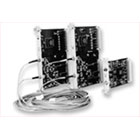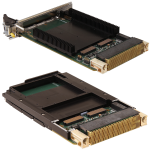
・No EMI generated by cables
・High-voltage isolation
・High-noise immunity
・Advantages over standard repeaters
・Small cables
・Maximum 6,560 ft (2,000 m) fiber-optic cables
・Total electrical isolation between VMEbus systems
・Supports 16-, 24-, and 32-bit addressing
・Software transparent allows direct communication from master chassis to slave chassis with no software overhead (unidirectional link control with bidirectional data transfers). This mode allows plug-and-play operation.
・Supports 8-, 16-, and 32-bit data transfers
・Register enable allows operation as described above, but includes registers in short I/O space dealing with slave chassis multimaster operation
・Supports a local master in slave chassis
・High-performance, easy-to-use method of linking two or more VMEbus systems together via fiber-optic cable
・High-voltage isolation
・High-noise immunity
・Advantages over standard repeaters
・Small cables
・Maximum 6,560 ft (2,000 m) fiber-optic cables
・Total electrical isolation between VMEbus systems
・Supports 16-, 24-, and 32-bit addressing
・Software transparent allows direct communication from master chassis to slave chassis with no software overhead (unidirectional link control with bidirectional data transfers). This mode allows plug-and-play operation.
・Supports 8-, 16-, and 32-bit data transfers
・Register enable allows operation as described above, but includes registers in short I/O space dealing with slave chassis multimaster operation
・Supports a local master in slave chassis
・High-performance, easy-to-use method of linking two or more VMEbus systems together via fiber-optic cable




